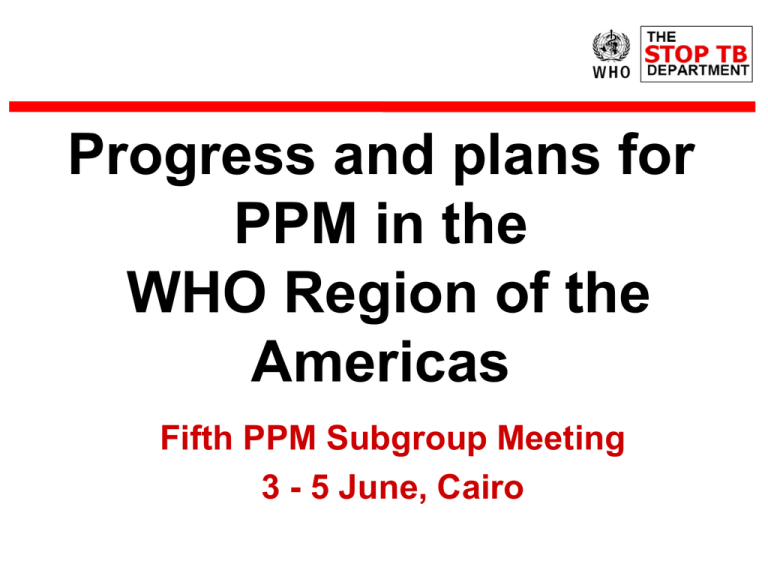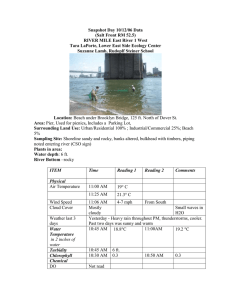Progress and plans for PPM in the WHO Region of the Americas
advertisement

Progress and plans for PPM in the WHO Region of the Americas Fifth PPM Subgroup Meeting 3 - 5 June, Cairo Regional PPM Progress Regional PPM Progress Strategic Lines of the Regional TB Plan for the Americas 1. Strengthening and/or expansion of quality DOTS 2. Implementation and/or strengthening of the TB/HIV collaborative activities, MDR-TB prevention and control and strategies for unattended populations 3. Contribution to health system strengthening 4. Involvement of all health providers 5. Empowerment of affected populations and their communities, and implementation of ACSM strategies 6. Operational, clinical and epidemiological research Regional PPM Progress The TB control is integrated in PHC by the MoH. % of the population with access to health care according to provider - PPM countries 2007 PROVIDER CATEGORY MoH DOR % BOL ELS BRA MEX ECU % % % % % 60 30 40 80 42 28 Public Insurance 7 25 20 6 57 21 Private Insurance 20 14 3 Total Pub sect + Insurance 87 100 99 For-profit or non profit Private Services 55 60 12 5 Without coverage 13 33 35 TOTAL 100 100 100 Salud en las Americas, OPS/OMS 2007 49 26 100 1 27 100 100 PPM activities in priority countries Priority countries National Situation assessment conducted PPM focal person appointed DOR Pilot area Yes BOL Pilot area Yes BRA Pilot area Yes ELS Non Yes MEX Pilot area Yes ECU Yes Yes PPM Operational guidelines developed Regional PPM Progress Results from PPM surveys in Latin America Regional PPM Progress Results from PPM surveys in Latin America Provider BOL BRA . % TB % TB dx Ttx Public 93.2 Private 4.5 94.4 3.3 % TB dx ELS % TB Ttx % TB Ttx Ref. % TB dx 86.8 98.9 97.8 100 100 87.7 87.7 76.7 13.2 0 12.3 12.3 23.3 1.1 Ref. % TB dx DOR 2.2 0 % TB Ttx Regional PPM Progress ACTIVITIES 2006-2007 Number Of countries PPM in the national action plan 10 Carried out the PPM survey protocol* (In pilot areas) 6 Carried out the PPM survey protocol (Whole country) 1 Map Providers (In a pilot area) 6 Map Providers (Whole country) 1 Assess NTP capacity for PPM 6 Selection of providers (Prioritization) 6 Defining the “task mix” 2 ISTC Endorsement by the MOH* 2 * In process (MEX, ELS and URU) Regional PPM Progress • To date, most of the NTPs have carried out alliances with other suppliers specially with the public sector not previously involved (hospitals, public insurance, prisons, military and police health services and others). • Other initiatives have been carried out with the universities and professional societies and to a lesser extent with NGOs and for-profit private sector. • The NTPs’ experience engaging private pharmacies and traditional medicine is scarce. Regional PPM Progress PPM PPM PPM PPM PPM Countries with PPM initiatives in place PPM MEX ELS DOR BOL BRA ECU PPM PPM Countries planned to initiate PPM COL GUA PAR URU PPM contribution to TB control in El Salvador El Salvador TB case notification all forms - 1990-2006 4500 STOP TB strateg y 80 4000 (Including PPM) 70 3500 60 3000 50 End of civ il war (1981-1992) 2000 1500 1000 500 0 DOTS Implementation 2500 Cases 40 30 20 Rate 10 1990 1991 1992 1993 1994 1995 1996 1997 1998 1999 2000 2001 2002 2003 2004 2005 2006 Cases 2367 2304 2495 3347 3901 2422 1686 1662 1700 1623 1485 1458 1550 1383 1407 1794 1644 Rate 45.7 43 46.3 62 70 43 29 28.1 28 27 24 23 24 21 20.8 26.1 23.5 ** Rate per 100,000 hab. * 1997 a 2005 Datos MSPAS/ISSS 0 Regional PPM Progress Mexico • National meeting to present the PPM objectives and action lines • Verification of degree of involvement of the NTP and the private sector • Validation of evaluation form for each state involved • Draft of validated National Standards of Care based on the ISTC and national TB norms • Agreements with the industry and federal laboratory • Agreements with schools of medicine and nursing • Agreements with national pharmacies association • Agreements with national private hospital association • Nine states (25%) already with PPM activities Regional PPM Progress Brazil • Agreement between the Ministry of Health and the Business and Industrial sector (SESI) for the diagnosis and treatment of TB in patients found in the work force of the sector. • Notification and reference of all TB cases within the health system (SUS) with guarantee of diagnosis and TB drugs financed by the MoH. • National Brazilian consensus for TB management with wide involvement of Pneumology Society, TB Research network and schools of medicine. • Ministerial resolution endorsing a TB control plan for prisons, indigenous population and TB/HIV. Brazil Provider group Involvement Professional associations Yes Corporate Sector Yes Hospitals Yes Informal providers NO Private laboratories Yes Prison Yes Industrial Sector Yes Contribution Constraints and challenges for PPM implementation in the Americas • Weakness of the NTP leadership in some countries • Limited experience in coordination, integration and alliances with other actors • Public and private insurance security focused on curative care • Segmented and disorganized private sector with limited interest. • Scarce knowledge of the role and coverage of the private sector, including private pharmacies. • Scarce knowledge of the participation of tradicional medicine Opportunities for PPM implementation in The Americas • PPM included in the Regional TB plan and several country plans, some with specific budgets and indicators. • PPM activities supported by the GFATM • Existence of technical and financial support from partners • Free TB drugs available • Some positive pilot experiences in countries and expansion already underway • ISTC available and Regional implementation guidelines developed • National Stop TB partnerships already organized in 4 countries: Brazil, Honduras, Mexico and Peru Regional Priorities 2008-2009 • Expand the PPM initiative at country level in BOL,ECU, DOR, BRA, MEX. • Carry out the PPM surveys in four countries (COL, PAR, GUAT, URU) and implement the PPM initiative • Promote the adoption of the ISTC and the Patient chart improve the quality on DOTS among all health providers. • Disseminate the implementation guidelines for the ISTC The adoption of the ISTC is recognized as a great opportunity to reach the objectives of TB control in the Region. Regional Priorities 2008-2009 • Strengthen advocacy efforts to include PPM activities in all TB country plans and Global Fund projects • Conduct PPM consultant training workshops at Regional level • Continue and strengthen technical support to countries for PPM planning and implementation including effective engagement of private laboratories and involvement of informal health care providers and pharmacies. The Americas involving all health providers in TB Control THANK YOU !


